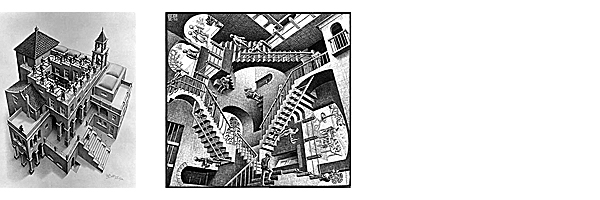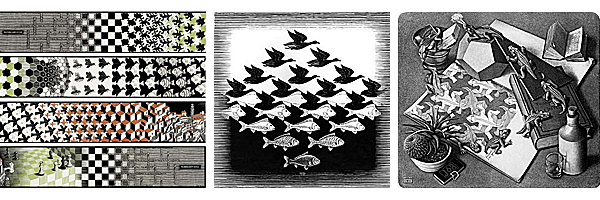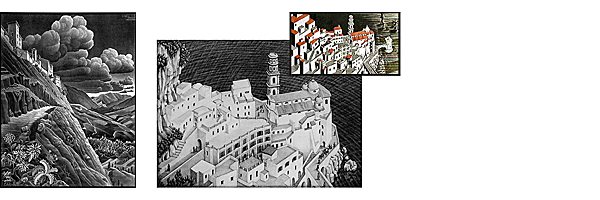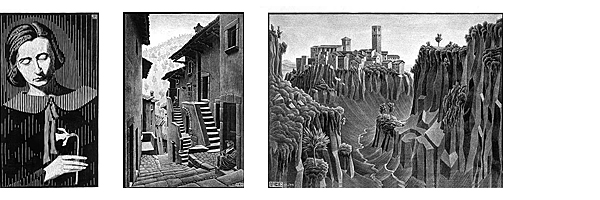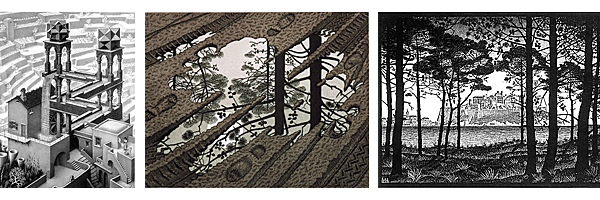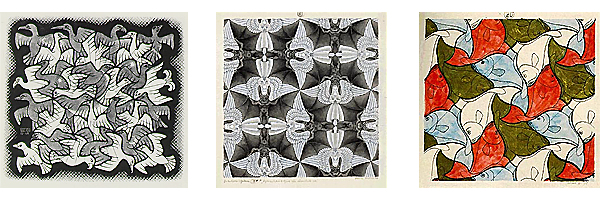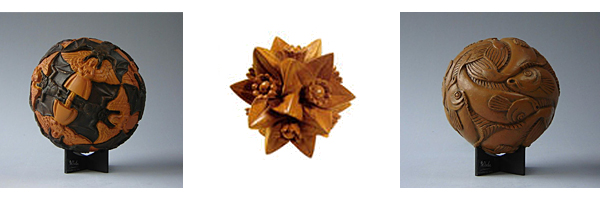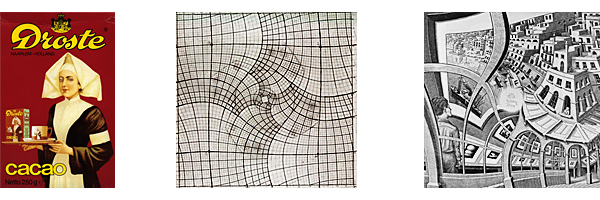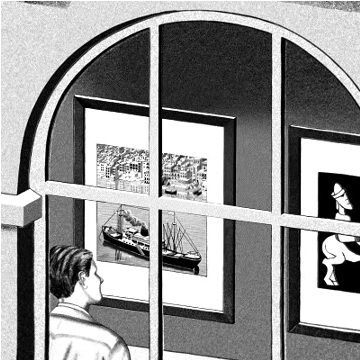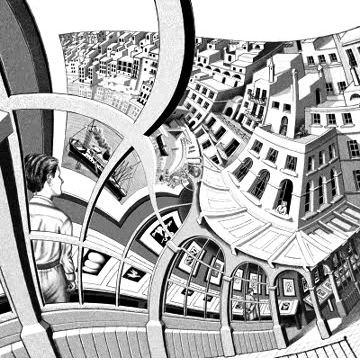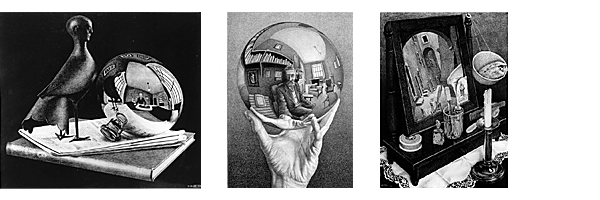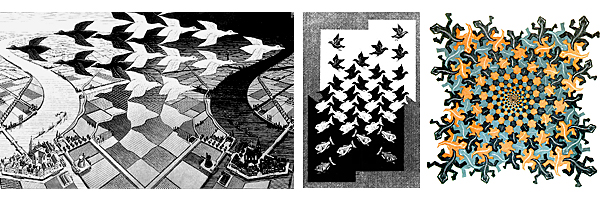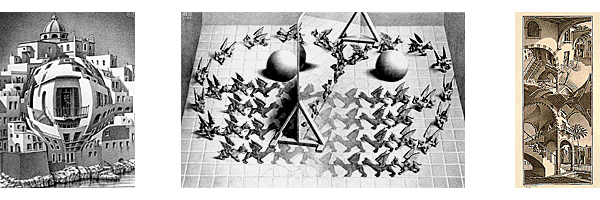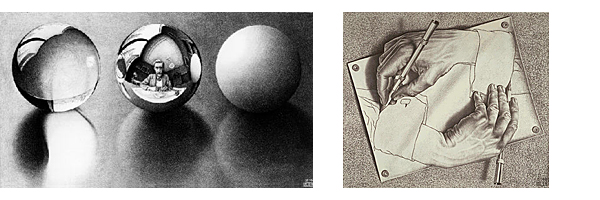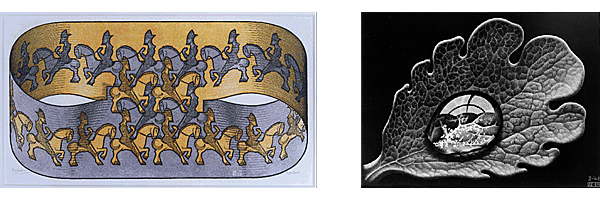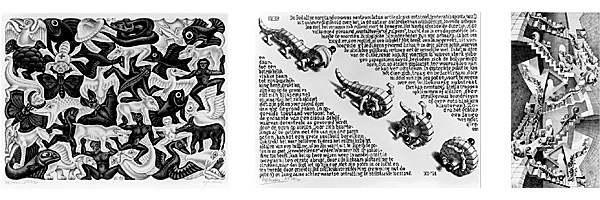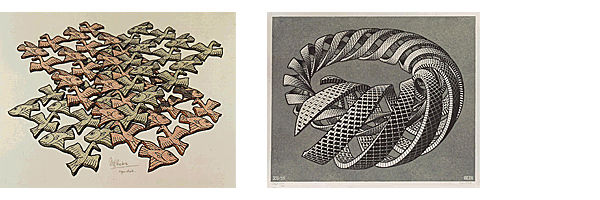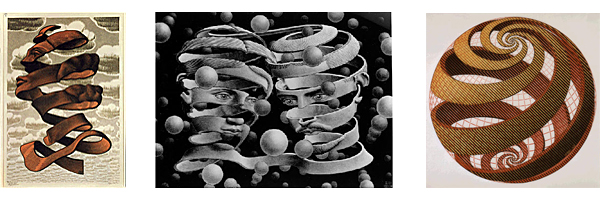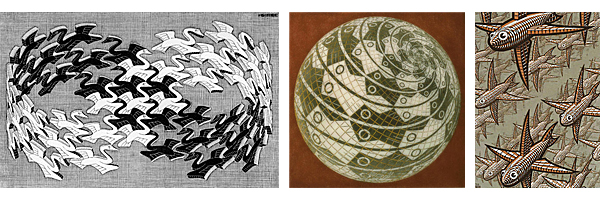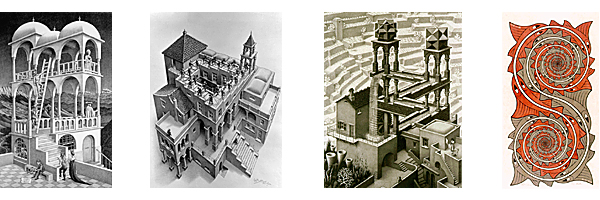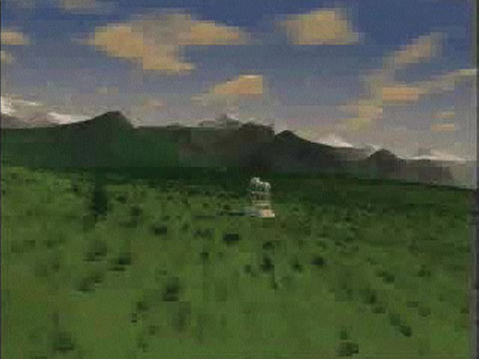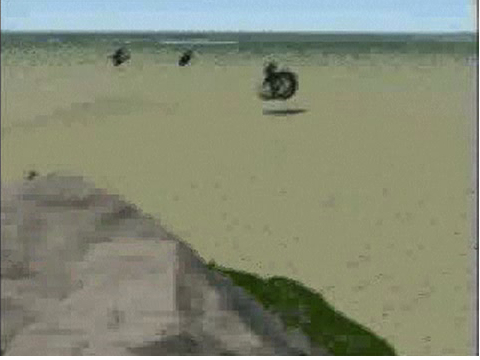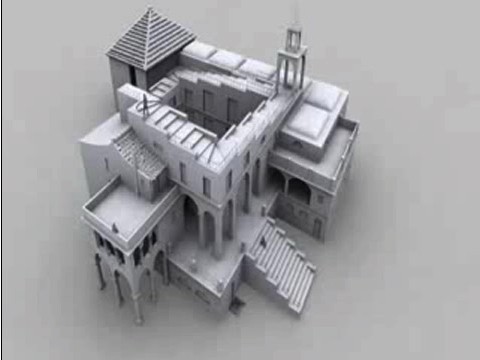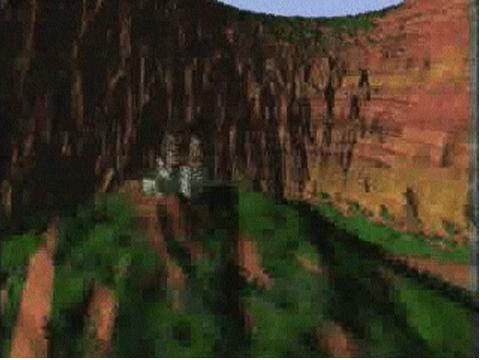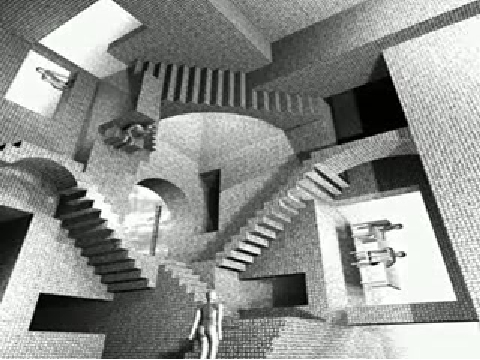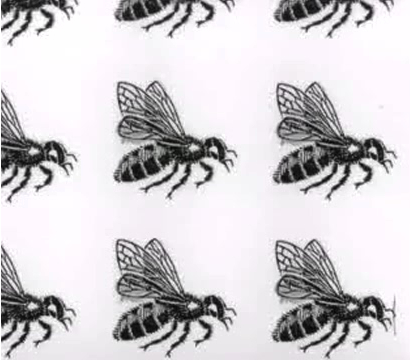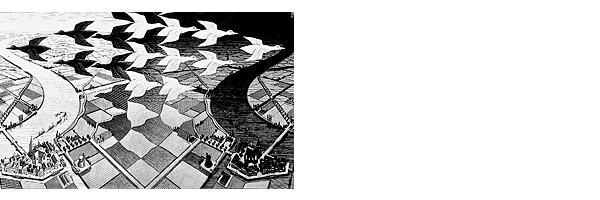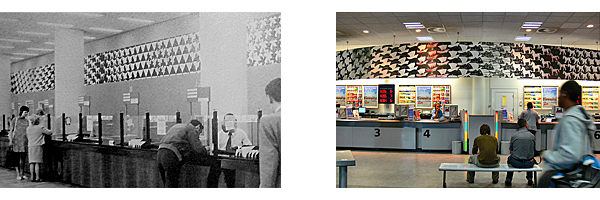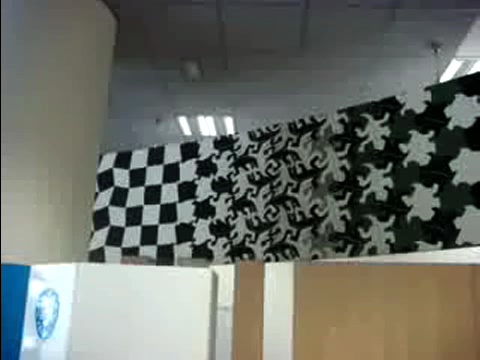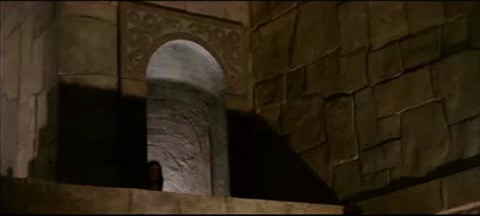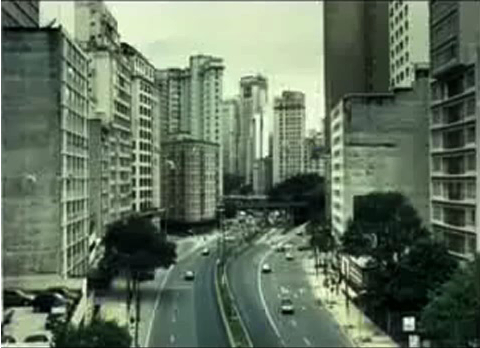M.C. ESCHER INFO
Quick Biography
Maurits Cornelis Escher (1898-1972) is one of the world’s most famous graphic artists. His art is enjoyed by millions of people all over the world, as can be seen on the many web sites on the internet.
He is most famous for his so-called impossible structures, such as Ascending and Descending, Relativity, his transformation prints, such as Metamorphosis I, Metamorphosis II (the horizontal art at the top of our web pages), and Metamorphosis III , Sky & Water I or Reptiles.
But he also made some wonderful, more realistic work during the time he lived and traveled in Italy.
Castrovalva for example, where one already can see Escher’s fascination for high and low, close by and far away. The lithograph Atrani, a small town on the Amalfi Coast was made in 1931, but comes back for example, in his masterpiece Metamorphosis I and II (right of center in the art at the top of our web pages).
M.C. Escher, during his lifetime, made 448 lithographs, woodcuts and wood engravings and over 2000 drawings and sketches. Like some of his famous predecessors—Michelangelo, Leonardo da Vinci, Dürer, and Holbein—M.C. Escher was left-handed.
Apart from being a graphic artist, M.C. Escher illustrated books, designed tapestries, postage stamps and murals. He was born in Leeuwarden, the Netherlands, as the fourth and youngest son of a civil engineer. After 5 years the family moved to Arnhem where Escher spent most of his youth. After failing his high school exams, Maurits ultimately was enrolled in the School for Architecture and Decorative Arts in Haarlem.
After only one week, he informed his father that he would rather study graphic art instead of architecture, as he had shown his drawings and linoleum cuts to his graphic teacher Samuel Jessurun de Mesquita, who encouraged him to continue with graphic arts.
After finishing school, he traveled extensively through Italy, where he met his wife Jetta Umiker, whom he married in 1924. They settled in Rome, where they stayed until 1935. During these 11 years, Escher would travel each year throughout Italy, drawing and sketching for the various prints he would make when he returned home.
Many of these sketches he would later use for various other lithographs and/or woodcuts and wood engravings, for example the background in the lithograph Waterfall stems from his Italian period, or the trees reflecting in the woodcut Puddle, which are the same trees Escher used in his woodcut “Pineta of Calvi”, which he made in 1932.
M.C. Escher became fascinated by the regular Division of the Plane, when he first visited the Alhambra, a fourteen century Moorish castle in Granada, Spain in 1922.
During the years in Switzerland and throughout the Second World War, he vigorously pursued his hobby, by drawing 62 of the total of 137 Regular Division Drawings he would make in his lifetime.
He would extend his passion for the Regular Division of the Plane, by using some of his drawings as the basis for yet another hobby, carving beech wood spheres.
He played with architecture, perspective and impossible spaces. His art continues to amaze and wonder millions of people all over the world. In his work we recognize his keen observation of the world around us and the expressions of his own fantasies. M.C. Escher shows us that reality is wondrous, comprehensible and fascinating. [ The M.C. Escher Company B.V. ]
Click here for a more detailed bibliography
DROSTE EFFECT
“Picture Gallery” Image
The Dutch chocolate maker, Droste, is famous for a visual effect on its boxes of cocoa. The image contains a ‘copy’ of itself on a smaller scale—a special kind of recursive picture. An image exhibiting the Droste effect depicts a smaller version of itself in a place where a similar picture would realistically be expected to appear. This smaller version then depicts an even smaller version of itself in the same place, and so on. Only in theory could this go on forever, practically it continues only as long as the resolution of the picture allows.
The effect is named after a particular image, that appeared, with variations, on the tins and boxes of Droste cocoa powder, one of the main Dutch brands. It displays a nurse carrying a serving tray with a cup of hot chocolate and a box of the same brand.
One way someone can create this effect for themselves is to film one’s own television with a video camera, while displaying the output of the video camera on the same television. Escher, wanting to elaborate on the effect, used his strong grasp of mathematics and transformations to develop a grid using curved lines instead of straight—and the image “Prentententoonstelling” (Picture Gallery) was born.
‘Standard’ Droste Effect Animation
This is an animation that zooms into a ‘standardized’ (square grid) picture that was reconstructed by a software program written by Joost Batenburg—with help from Dutch artists Hans Richter and Jacqueline Hofstra.
[ VIDEO COMING HERE (Though it is in our M.C. Escher ‘playlist’ on our YouTube ‘channel’) ].
‘Infinite’ Droste Effect Animation
The team also “filled the hole” in Escher’s original image to create a ‘infinite’ image. The animation below starts and stops on the same image, so if you play it continuously, it would appear to be zooming in infinitely.
[ VIDEO COMING HERE (Though it is in our M.C. Escher ‘playlist’ on our YouTube ‘channel’) ].
ADDITIONAL IMAGES
Some More of Our Favorites
Escher was very prolific in creating art, most of it of a ‘ground-breaking’ nature. The following are the ones we enjoy.
ANIMATIONS
“Belvedere” Animation
The following animations were created for a large retrospective exhibition in 1998 at the “Kunsthal” in Rotterdam. FCC/Wennekes Multimedia was the company that developed these “virtual rides” of some of Escher’s work.
[ VIDEO COMING HERE (Though it is in our M.C. Escher ‘playlist’ on our YouTube ‘channel’) ].
“Ascending and Descending”
Animation
Are you sure that you ‘rise higher’ when you walk upstairs?
[ VIDEO COMING HERE (Though it is in our M.C. Escher ‘playlist’ on our YouTube ‘channel’) ].
“Waterfall” Animation
Here’s how the water at the bottom of a waterfall can flow back uphill to go over the waterfall again.
[ VIDEO COMING HERE (Though it is in our M.C. Escher ‘playlist’ on our YouTube ‘channel’) ].
“Relativity” Animation
Here’s a place where you don’t know whether you’re coming or going (Scroll down a bit to see how this ‘illusion’ was used in a relatively recent movie).
[ VIDEO COMING HERE (Though it is in our M.C. Escher ‘playlist’ on our YouTube ‘channel’) ].
Birds-to-Fish ‘Morphing’
Here’s an area of the “Metamorphose II” graphic showing fixed in one place what one would see if they scrolled hoizontally.
[ VIDEO COMING HERE (Though it is in our M.C. Escher ‘playlist’ on our YouTube ‘channel’) ].
MORE INFORMATION
Exploring Further
Why are M.C. Escher’s images so hugely popular? Is the real attraction in his visual paradoxes, or in the poetry of his mosaics? How did Escher go about creating his works? What were the sources of his inspiration? What kind of person was he?
“The whole room, four walls, the floor, and the ceiling, everything, albeit distorted, is compressed into that one small circle…No matter how you turn or twist yourself, you can’t get out of that central point [between your eyes]. You are immovably the focus of your world” (Escher, 1989, p. 60).
We invited you to explore further the life and work of this remarkable artist. The following will help you do that.
M. C. ESCHER BIBLIOGRAPHY:
• M.C. Escher: His Life and Complete Graphic Work – J.L. Locher, Amsterdam, 1981
• Een Biografie – W. Hazeu, Amsterdam, 1998 (Dutch version only)
• The Graphic Work of M.C. Escher – M.C. Escher
• The Magic of M.C. Escher – J.L. Locher and W.F. Velghuysen, New York and London, 2000
• M.C. Escher: Visions of Symmetry – D. Schattschneider, New York and London, 2004
• Escher on Escher: Exploring the Infinite – M.C. Escher, Amsterdam, 1986
• The Magic Mirror of M.C. Escher – Bruno Ernst, Amsterdam, 1976
• MCEscher-PathsToPerception-2009Exhibition (Offered original prints) [PDF]
SOME WEB SITES ABOUT M. C. ESCHER:
• The Official M.C. Escher Web Site
• Escher and the Droste Effect
• M.C. Escher Mindscapes
• Totally Tessellated
• Knight Tour Tessellations
• The Mathematical Art of M.C. Escher
• M.C. Escher in Popular Culture (Wikipedia)
TRANSFORMATIONAL
Appealing to Our ‘Sense’ of Wonder
In 1937, Escher heralded a new period in art by creating “Metamorphosis I,”—depicting the transformation from the two-dimensional to the three-dimensional (the gradual transition of a Chinese doll to a small town).
Escher once said, “He who wonders discovers that this in itself is wonder.” Escher’s art draws the viewer into a sense of wonderment. His most ‘popular’ print, “Day and Night,” took this transformational concept in two directions simultaneously—the gradual transformation from day to night going left to right, and from earth to the heavens going from the bottom to the top.
The concept of transformation that Escher perfected is something we strive for too—connecting your marketing message with those who would best profit from your product or service.
Escher expressed this well when he said, “I do indeed believe that there is a certain contrast between, say, people in scientific professions and people working in the arts. Often there is even mutual suspicion and irritation, and in some cases one group greatly undervalues the other. Fortunately there is no one who actually has only feeling or only thinking properties. They intermingle like the colors of the rainbow and cannot be sharply divided. Perhaps there is even a transitional group, like the green between the yellow and the blue of the rainbow. This transitional group does not have a particular preference for thinking or feeling, but believes that one cannot do without either the one or the other. At any rate, it is unprejudiced enough to wish for a better understanding between the two parties…It is clear that feeling and understanding are not necessarily opposites but that they complement each other.”
In 1967, just a few years before Escher’s death, the director of “Posts and Telegraphs,” Engineer Bast, came to him to encourage him to do a larger ‘metamorphosis’. Bast had been looking at a large print of the 1940 “Metamorphosis II” in his board room, and thought that it would fit well in one of the general post offices in The Hague. Escher planned to make the new one 4 times larger (original was 4 meters long), so its proportions would work with the very long wall of the post office. What Escher had planned never did get finished, but he did do an additional 3 meters—which is what is commonly referred to as “Metamorphosis III, and can be seen today hanging throughout the post office in the city center just across from the old Town Hall, Kerkplein 1.
[ VIDEO COMING HERE (Though it is in our M.C. Escher ‘playlist’ on our YouTube ‘channel’)
Since Escher’s passing, there have been many examples of using his unique ‘view’ of the world. A few we like are the use of the “Relativity” (stairs on different planes) in the “Labyrinth” movie in 1986, and the use of many of his ‘illusions’ in a commercial for the new Audi A6 in 2005.
[ VIDEO COMING HERE (Though it is in our M.C. Escher ‘playlist’ on our YouTube ‘channel’)
[ VIDEO COMING HERE (Though it is in our M.C. Escher ‘playlist’ on our YouTube ‘channel’)
We at Visual Impact Sytems continually strive to keep our ‘sense of wonder’ to help us better understand the intrinsic possibilities hidden in all of the opportunities to complement your marketing message in a transformational way.
[ All M.C. Escher works are copyrighted by Cordon Art B.V., Baarn, the Netherlands, and The M.C. Escher Company, B.V. All Rights Reserved – Official website: http://www.mcescher.com/ ].

